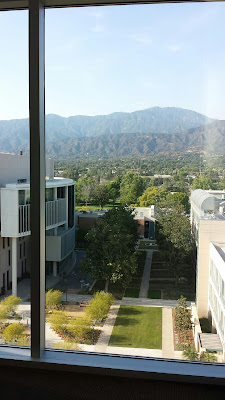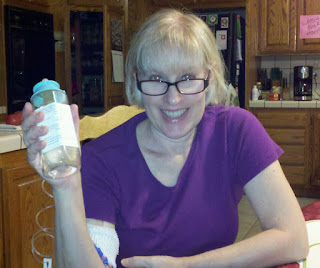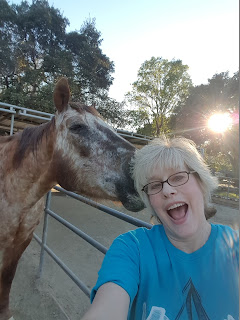7.5.2017
Wow, can it be? Yes, 7 years ago today I received my own Stem Cells back, in hopes of revitalizing and regenerating my system after months of intensive chemotherapy, with the hope of finally pummeling myeloma outta my universe.
It was mid morning July 5, 2010, with not much fanfare or dramatics, my nurses came in to my hospital room, checked my vitals, checked my IV's, hung a few new bags of "magic potions", (probably hydration, anti nausea meds, etc, can't recall...), and let me know my Stem Cells would be arriving at any time. I was still in a daze about this whole myeloma cancer situation, not to mention being a hospital inpatient, that I just "went along for the ride", nodding my head and agreeing to whatever the professionals said would be the next event. I always felt like I was an imposter, or my diagnosis was a mistake, or I was participating in some sort of "professional in-service" workshop, as it was, and still is, so difficult for me to fully relate to, and accept my illness status.

But catheter lines connected to my main arteries, tubes coming out of my chest, IV bags galore infused into my body 24/7, nurses and doctors rushing in and out of my IN-patient hospital room, all confirmed my reality: That I have a very serious illness called cancer, specifically myeloma, I'm really sick, I'll be sick forever, but this Stem Cell Transplant infusion process will buy me time. How much time, I didn't know back then. No one knew. No one knows now. But here I am, 7 years later! Treatment seems to be an oxymoron: "Precision Guessing" lol.
And the door opens. A quiet, reserved young lady wheels in an ice chest, says hello and that she is here to deliver my Stem Cells!

Didn't seem like a big deal to me. No bells and whistles. No band playing. No wild partying or revelry. Hubby Jim and Daughter Alissa were on their way, but it was just me, the Cyrogenic Lab Tech delivery lady and my Nurse Susan. Back then I just had my little "Razor" flip phone for a camera, and I had only taken a few pictures up to that point. I wasn't as connected on social media or this blog that long, so I wasn't taking a zillion pictures or selfies back then. But I stopped her and said, "wait, please let me get a picture of you holding my stemmies"! She obliged, but shyly. Click, there they were. Saved forever in just one blurry picture. Nurse Susan came and hung the bag, connecting my 5 million stemmies to my Hickman Catheter, and off my stemmies flowed, infused back into by body. No pain, no drama, so very undramatic. Me of course thinking, "ok, so what's the big deal to a Stem Cell Transplant"? "This is so very anticlimactic", I thought. But I soon came to find out exactly WHAT the BIG deal was to this whole process. It's not the actual stem cell INFUSION process itself, it's what the 2 days (prior) of HIGH DOSE MELPHALAN CHEMO, does to one's body. THAT is THE BIG DEAL.

Fortunately, Jim and Alissa made in,
just as my stemmies were almost all infused.
And so the days passed. First few days after infusion I felt ok. Then slowly not ok. I was moved from the 6th floor to the 5th floor. I remember so many medical professionals coming in to see me. I called it the "Parade of Professionals". Nurses, Doctors, Social Services, Occupational Therapists, Exercise Therapists, LVNs, RNs, Dieticians, cleaning staff, on and on and on. Seriously, never a dull moment. I was so exhausted. My phone would ring. I had so little energy to answer and chat. I got so I couldn't talk. Too physically weak. Too emotionally drained and affected. Everything became an effort. Getting to my little bathroom, just steps away from my bed, like a marathon challenge. I tried to hydrate and eat a bit, but I was so cautious, as I didn't want to be sick. I began keeping the TV on 24/7. I needed "noise", needed distraction from my own thoughts and feelings. I was going down hill. My immune system was crashing. I felt awful. I developed a fever. My Hickman Catheter became infected, septic. Doctors and Nurses determined it was so infected it had to be removed. And fast. So fast, they sent a Surgeon in to my room to perform "bedside surgery". I remember "seeing the light"... thinking this is it... I'm outta here... I'm going... but I woke up hours later, no catheter, many worried faces, multiple bags of IV antibiotics flowing, into an IV now in my arm. Catheter gone. I then understood what the stem cell transplant BIG DEAL was.
It's the chemo CRASH! My immune system was now Neutropenic.
Nadir had happened. Melphalan had killed most everything. Good and Bad. My body now has to rebuild me back to health... if I am going to make it... The plan: my stem cells to the rescue. Regenerate my immune system, give me strength, give me power to fight, give me my life back.

My view all of July 2010
Although my stay was difficult,
I had the best of care, with the best professionals
and I will always be indebted to the COH SCT staff!
Yes, my whole month at City of Hope Hospital was one of my most challenging events of my life. I think more emotionally, than physically. Slowly my body healed.
Engraftment happened. Slowly my immune system rallied and built back up. Slowly I learned patience. Slowly I learned I was not in control any more. Slowly I began to accept I had terminal cancer, and I would never ever be who I was, before diagnosis. Slowly my body healed. But I was told, my ticket out of the hospital was accepting a new port for my IV meds. See, after my Hickman "blew up" due to the extreme infection (probably due in part to me being allergic to the bandages, and not keeping it properly covered initially), I was terrified to accept another implanted port. But my nurses and doctors let me know, no port, no going home. My ticket to freedom was accepting a Picc line, port-a-cath, a little port installed in my upper arm, to allow home health care nurses to come and help me administer antibiotics, for weeks, months? I accepted. I accepted the port on July 26, 2010.

Here I was, back then, with my super cool
home IV antibiotic "bag in a bottle" infusion apparatus
Late Wednesday, July 28th, I was released from the hospital, and my family brought me home. I cried the whole way home. I cried from relief. I cried from pure exhaustion. I cried because I never thought I would get out of the hospital alive. I cried because I felt the sun in my face, and the wind in what little hair I had left. I cried because I had held in so many emotions for so long, and they just poured out. I cried because I knew there was now hope that I could be "Julie" again. Just Julie. Not Julie the sick hospital inpatient, battling for her life, but Julie, breathing in life, exhaling illness and inhaling sunshine, nature, scented roses and whispering pine trees, horses swishing tails on moonlit nights, and I could once again, laugh with my family, friends and colleagues.
And here I am, 7 years later, so lucky to be here
doing all the little things I never thought I'd be able to do,
back during those long, painful days and nights in the hospital...
7 years later... wow!
Happy 7th SCT to me :))
Live happy,
live well, and make a difference somewhere, somehow, with someone or something
as often as you can








No comments:
Post a Comment